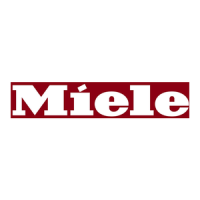
Do you have a question about the Miele T 6751 and is the answer not in the manual?
| Energy Efficiency Class | A++ |
|---|---|
| Noise Level | 65 dB |
| Color | White |
| Appliance placement | Freestanding |
| Drying system | Heat Pump |
| Type | Heat-pump dryer |
| Drying Programs | Cotton, Delicate, Wool |
| Loading type | Front loading |
Warnings about flammable substances, cleaning agents, and potential chemical reactions.
Guidance on dryer shut-off alerts, accessory usage, and noise emission data.
Instructions for safely disposing of the old appliance.
Information on the environmentally friendly disposal and recycling of packing materials.
Guidance on recycling old machines and contacting local authorities.
Diagram illustrating the external components and features of the tumble dryer.
Description and numbering of the controls and indicators on the appliance's control panel.
Explanation of indicator lights for program status and fault identification.
How to use the program selector dial to choose and start drying programs.
Details on the purpose and operation of the various push buttons.
Information on what the display shows regarding residual moisture, time, and temperature.
Explanation of the selector button's role and the meaning of different indicator lights.
Instructions for operating the emergency stop button and its reset procedure.
A reference table for converting temperatures between Celsius (°C) and Fahrenheit (°F).
Steps for preparing the dryer before its first operation, including cleaning the drum.
Guidance on sorting laundry, checking care labels, and preparing items for drying.
Detailed steps for selecting and initiating a drying program using the control panel.
A list and brief explanation of the different drying programs offered by the appliance.
Instructions for utilizing special wet cleaning programs for specific fabric types.
Guidance for drying bedding items, including necessary reprogramming steps.
Steps to follow after a program finishes, including removing laundry and turning off the machine.
Instructions for shutting down and preparing the dryer for periods of inactivity.
Explanation of the automatic anti-crease cycle to minimize creasing after drying.
How to safely interrupt a program and then resume or select a new one.
Details on using the emergency stop button and the procedure to reset it.
Guide to reprogramming individual drying programs to meet specific operational needs.
Steps required to set the unit to its basic position before making program modifications.
A practical example illustrating how to reprogram the drum reversing action period.
Instructions on how to exit the reprogramming function after completing changes.
A step-by-step guide to changing the residual moisture values for specific programs.
A detailed table outlining program alterations, selector positions, options, and notes for reprogramming.
Table showing adjustable residual moisture settings for various programs across different models.
Instructions for cleaning the machine's exterior, including specific guidance for stainless steel surfaces.
Procedures for cleaning the dryer drum and the lint filter for optimal performance and safety.
Details on essential yearly maintenance tasks to be performed by an authorized Miele technician.
Explanation of sequence lights and fault indicators for program status and error detection.
Covers heating faults, safety period issues, venting problems, and lint filter clogs with corrective actions.
Clarification of indicator flashes during power failures or program interruptions, not indicating a fault.
Information on how to reach Miele Technical Service for assistance and inquiries.
Guidance on locating the machine's data plate for model and serial number identification.
A comprehensive explanation of the various symbols and their meanings found on the appliance's data plate.
Critical safety precautions to be observed during the installation of the tumble dryer.
Guidelines for proper exhaust ducting, ventilation, and air intake for optimal operation.
Considerations for the installation room environment, avoiding frost, fumes, and ensuring proper clearances.
Instructions on how to level the machine using adjustable feet for stable and correct operation.
Detailed steps for electrical connection, including voltage, frequency, grounding, and phase verification.
Important instructions and considerations for connecting the appliance to a steam supply.
Notes on protecting the heat exchanger from damage and corrosion during installation and operation.